![]()
![]()
![]()
Use LEFT and RIGHT arrow keys to navigate between flashcards;
Use UP and DOWN arrow keys to flip the card;
H to show hint;
A reads text to speech;
120 Cards in this Set
- Front
- Back
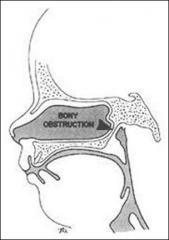
what
|
choanal atresia, can be a/w CHARGE - Coloboma, Heart defect, choanal Atresia, Retardation, Genital, Ear anomaly
|
|
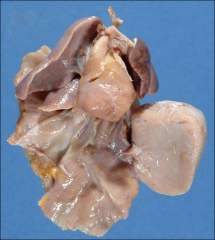
what
|
extralobar pulmonary sequestration
|
|
|
major cause of intralobar pulmonary sequestrations
|
repeated bouts of pneumonia
|
|
|
histologic findings in pulmonary sequestration
|
prominent vessels (b/c systemic supply)
|
|
|
histology of bronchogenic cyst
|
respir epith with smooth muscle directly underneath
|
|
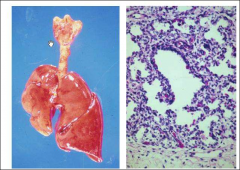
what
|
pulmonary hypoplasia, note small acini
|
|
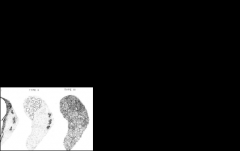
what
|
cpam two additional types (type 0- acini don't form and type 4 peripheral cyst
|
|
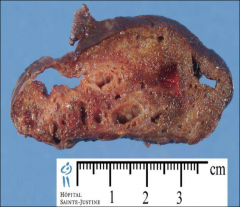
what
|
cpam - no cyst >2 cm and not microcystic so type II
|
|
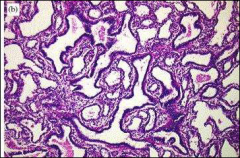
what
|
cpam type II
|
|

what, causes
|
something that compresses bronchus, infantile lobar emphysema
|
|
|
three big problems facing prematuriry (<37 weeks)
|
intraventricular hemorrhage (from germinal matrix)
necrotizing enterocolitis hyaline membrane dz |
|

what
|
bronchopulmonary dysplasia - following RDS, alternative areas of scarring/alveolar hyperinflation and compression
|
|
|
where is diaphragmatic hernia most found
|
posterior lateral, left>right
|
|
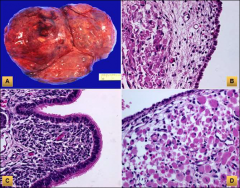
what
|
pleuropulmonary blastoma: malignant mesenchymal tumor
more cystic in younger, more solid in older (usu <4 yrs) (note: rhabdo focus in D) |
|
|
who think of
Aortic coarctation- |
Turner syndrome
|
|
|
who think of
• Anomalies of the aortic arch: |
Del 22q syndrome
|
|
|
who think of• Malformations of the AV septum
|
Down syndrome
|
|
|
four parts of tetraology of fallot
|
Infundibular pulmonic stenosis
Aortic valve dextroposition Ventriculoseptal defect Right ventricular hypertrophy |
|
|
what does hypoplastic left heart syndrome need
|
PDA
|
|
|
if you have complete transposition of vessels - what do you need
|
VSD
|
|
|
what is Heterotaxy syndrome
|
paired organs have mirror images
|
|
|
histological word association, syndromic associaiton: rhabdomyoma
|
TS, spider cells
|
|
|
most common place for duplications in GI tract
|
ileum
|
|

what
|
duplication of GI tract
|
|
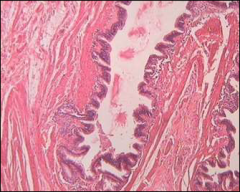
what
|
duplication histologically
|
|
|
most common congenital anomaly of GI tract
|
Meckel's, vitelline duct remnant
|
|

what
|
intussuception
|
|
|
underlying cause of hirschsprung's
|
failure of neural crest cells to migrate (wks 5-12)
|
|
|
syndromic association with Hirschsprung's dz
|
down's
|
|

what
|
hirschsprung's
|
|
|
histologic fx of hirschprungs
|
submucosa as thick as mucosa
hyperplastic peripheral nerves aganglionic ACE stain shows nerve fibers extending into lamina propria |
|
|
fx of Allergic proctocolitis
|
usu develp by 6 months, very often outgrow (can mimic hirschsprungs)
|
|
|
two HLA types for celiac
|
HLA-DQ2 and HLA-DQ8
|
|
|
protein reacting to in celiac
|
gliadin, a prolamin (gluten protein)
|
|
|
associated immunologic d/o in celiac
|
IgA deficiency
|
|
|
ab in celiac
|
Tissue transglutaminase-TTG,
antigliadin endomysial Abs |
|
|
most common polyp in kids
|
juvenile polyp
|
|
|
increased risk of ca with solitary juvenile polyp?
|
nope
|
|
|
where are juvenile polyps most frequently found
|
distal
|
|
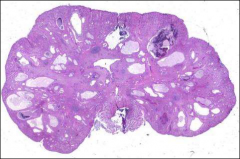
what
|
juvenile polyp
|
|
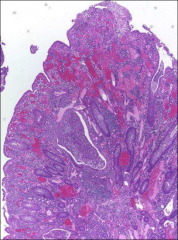
what
|
inflammatory pseudopolyp
|
|
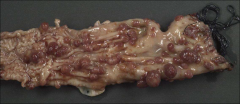
what
|
juvenile polyposis syndrome (not clusters like PJ polyp and larger so maybe not FaP)
|
|
|
cf age of onset juvenile polyposis syndrome vs. fap
|
jp syndrome: childhood, fap adolescence
|
|
|
mutations for juvenile polyposis
|
SMAD-4 (18q21.1) and BMPR1A (10q22.3)
|
|
|
mean age of cancer development in juvenile polyposis
|
30's
|
|
|
transmission and gene in peutz-jeghers
|
Autosomal dominant
• SKT11 gene (19p13.3) |
|
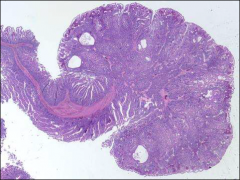
what
|
peutz-jegher polyp
|
|
|
where peutz-jegher polyp arise
|
Jejunum, ileum, duodenum, colon, stomach
|
|
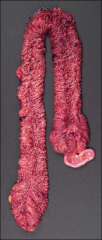
what, what gene
|
fap, APC, czome 5?
|
|
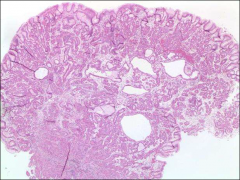
what, associations
|
PPI, FAP
|
|
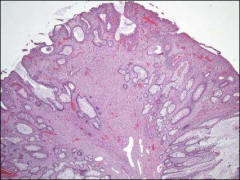
what, associations
|
ganglioneuroma, cowden, NF1
if diffuse, thickening of muscularis: think NF1 and MENIIb |
|
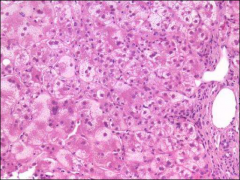
what, associations
|
neonatal hepatitis
infectious!! CMV • Rubella • Hepatitis B • Herpes simplex • Varicella • Coxsackie • Echo |
|
|
histologic fx of neonatal hepatitis
|
gc formation,
cholestasis hepatocyte ballooning acidiphil bodies inflammation |
|
|
Most frequent cause of liver transplantation in children
|
extrahepatic biliary atresia
|
|
|
can you get kernicterus in biliary atresia
|
not usually, can still conjugate bilirubin
|
|

what
|
extrahepatic biliary atresia:
bile duct proliferation Ductal bile plugs Portal fibrosis |
|
|
what is choledochal cyst
|
cystic dilation of biliary duct
|
|
|
what is caroli's dz
|
Cystic dilatation of intra hepatic biliary ducts
|
|
|
what is alagille syndrome
|
- bile duct paucity
- congenital heart - butterfly bone shape to some of vertebral bodies - eye defects, etc. AD disease JAG1 mutations |
|
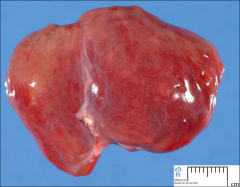
what
|
liver of AR PKD, congenital hepatic fibrosis, see white streaks?
|
|
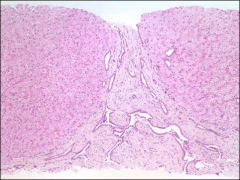
what
|
congenital hepatic fibrosis: Portal fibrosis with dilated biliary channels
|
|
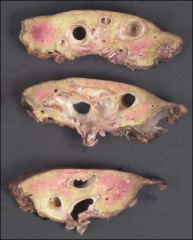
what
|
caroli's disease
|
|
|
if you don't die of fulminant liver dz in infancy with a1 antitrypsin deficiency, what can happen to liver as adult
|
HCC
|
|
|
what affect does OCPs have on FNH in liver
|
no increase of incidence, may increase bleeding
|
|
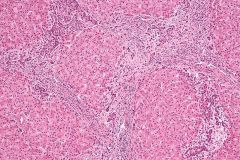
what
|
FNH
a lobular proliferation of bland-appearing hepatocytes with a bile ductular proliferation and malformed vessels within the fibrous scar |
|
|
Most common liver tumor
of early childhood |
hepatoblastoma
|
|
|
four syndromes associated with hepatoblastoma
|
Familial adenomatous polyposis
Beckwith-Wiedemann Syndrome Li-Fraumeni syndrome: Trisomy 18: |
|
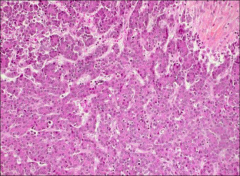
what
|
hepatoblastoma, embryonal
be aware can have mesenchymal component to any of hepatoblastoma forms |
|
|
some important causes of renal dysplasia (read through)
|
Tuberous sclerosis complex
• von Hippel-Lindau syndrome • Beckwith-Wiedemann syndrome • DiGeorge syndrome • Prune-belly sequence • Trisomies 13, 18, and 21 • Fetal alcohol syndrome • Diabetic embryopathy |
|

what and histologic findings
|
renal dysplasia, bland epith, benign intervening stroma, can see cartilage, etc.
|
|
|
gene and gene product of AR PKD
|
PKHD1 (6p21) Fibrocystin
|
|
|
gene and gene product of of AD PKD
|
PKD1 (16p13.3) Polycystin-1
PKD2 (4q13-4q23) Polycystin-2 |
|
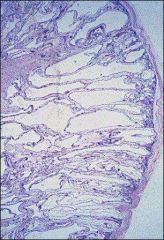
what, what findings in liver
|
AR PKD, congenital hepatic fibrosis
|
|
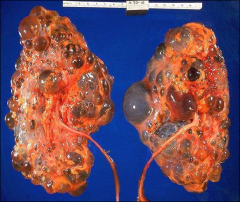
what
|
AD PKD
|
|
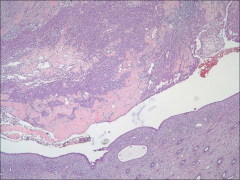
clinical course, associations
|
aggressive (often mets/LVI), hemoglobinopathies (includ c)
|
|
|
three elements to Wilms
|
blastema, epithelial, stroma
|
|
|
three major syndromes associated with wilms
|
beckwith-wiedemann
Denys-Drash WAGR |
|
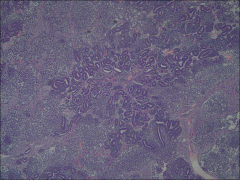
what
|
wilms
|
|
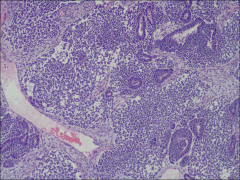
what
|
wilms
|
|
|
Most common
renal tumor of infancy |
mesoblastic nephroma
|
|
|
two types of mesoblastic nephroma and cytogenetic findings
|
1. more fibromatosis
2. cellular, like infantile fibrosarcoma t (12;15) |
|
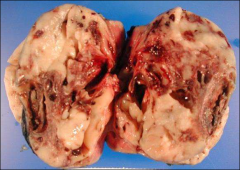
what
|
mesoblastic nephroma
|
|

what
|
mesoblastic nephroma
|
|
|
cf teratomas in ovary and testis
|
ovary: most are pure and immature neuroepithelium dictates prognosis
testis: rarely pure, usually component of mixed GCT; age is decider of outcome: prepubertal benign, postpubertal malignant |
|
|
standout ihc: seminoma
|
PLAP, CD117, OCT 3/4,
|
|
|
standout ihc: embryonal ca
|
PLAP, CD30, OCT 3/4
others: CK7+, AE1/AE3 |
|
|
standout ihc: yolk sac
|
AFP, AE1/AE3
|
|
|
standout ihc: chorioca
|
HCG, CEA, inhibin
|
|
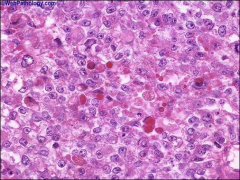
what
|
yolk sac, hyaline globules, microsieve pattern
|
|
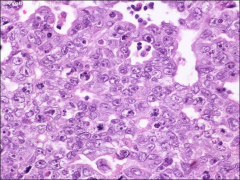
what
|
embryonal ca - ugly overlapping cells
|
|
|
most common site, gender for teratoma
|
girls, sacrococcygeal (take coccyx to avoid recurrence/yolk sac/endodermal sinus tumor
|
|
|
most common malignant tumor in childhood
|
brain
|
|
|
second most common malignant tumor in childhood
|
neuroblastoma
|
|
|
most common site of neuroblastoma
|
adrenal
|
|
|
genetic findings of neuroblastoma
|
17q gain
1p deletion Nmyc amplification DNA hyperdiploidy |
|
|
high risk neuroblastoma fx
|
• Stage 3 or 4
• Age 1-5 yr • Schwannian stroma-poor, GNB nodular, unfavorable subset • Nmyc amplified • 17q gain common • loss of 1p common |
|
|
Characteristic translocations involve EWS
|
22q12 with either
FLI1 (90-95%) 11q24 or ERG gene at 21q22 |
|
|
bad prognostic factors for Ewing's/PNET
|
• > 18 years
• Pelvis • Tumor > 8cm greatest dimension • Metastatic disease present at diagnosis • < 90% necrosis following chemotherapy • Type 2 EWS-FLI1 fusion transcript |
|
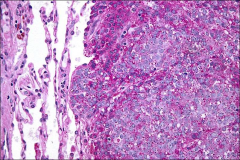
what
|
ewings/pnet with PAS stain
|
|
|
top two sites for rhabdomyosarcoma
|
H&N
GU |
|
|
immunophenotype for rhabdomyosarcoma
|
myogenin, myoD1, desmin in alveolar (embryonal doesn't stain as well)
|
|
|
which is more aggressive alveolar or embryonal rhabdomyosarcoma
|
alveolar, which, unlike embryonal, tends to be more in exxtremities
|
|
|
specific cytogenetic alterations in rhabdomyosarcoma (and importantly which subtype)
|
• t(2;13)(p35;q14)
• t(1;13)(p36;q14) ASSOCIATED WITH ALVEOLAR |
|
|
where does malignant rhabdoid tumor arise
|
kidney, cerebellum
|
|
|
what is the important ihc for rhabdoid tumors
|
loss of INI1 staining: SMARCB1) on chromosome 22q
classic tumor suppressor gene |
|
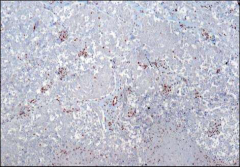
if this is rhabdoid tumor what is the ihc
|
loss of INI1
|
|
|
cytogenetic abnormality in infantile fibrosarcoma (and what other two tumors)
|
t(12;15) with novel fusion protein (TEL (ETV6) with NTRK3)
• Same translocation as in cellular mesoblastic nephroma and secretory carcinoma breast |
|
|
cytogenetic abnormality in secretory carcinoma breast
|
t(12;15) with novel fusion protein (TEL (ETV6) with NTRK3)
|
|
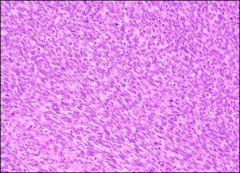
what
|
infantile fibrosarcoma, t(12;15)
|
|

sites for above, what
|
langerhans histiocytosis
bone, skin, lung, LN |
|
|
what are the langerhans cells involved in
|
ag presentation
|
|
|
ihc for langerhans
|
S100, CD1a, langerin
|
|
|
EM: pentilaminar invaginations of cell membranae
|
birbeck granules,
LCH |
|
|
most common pediatric tumor
|
hemangioma
|
|
|
which hemangiomas involute: congential or infantile
|
infantile
|
|
|
which hemangiomas express glut1: infantile or congenital
|
infantile (the ones that involute)
|
|
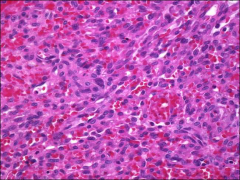
what
|
kaposiform hemangioendothelioma
|
|
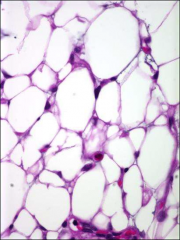
what
|
lipoblastoma
|
|
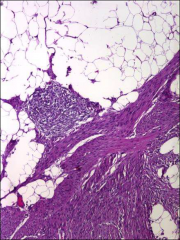
what
|
fibrous hamartoma of infancy
fibrous and adipose tissue and nests of immature mesenchyme |
|
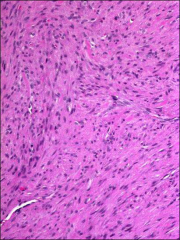
3 year old, sma+
|
myofibroma
|

